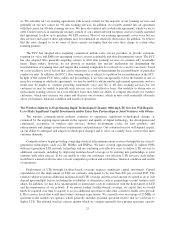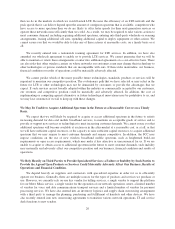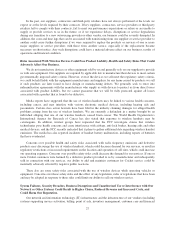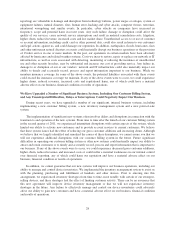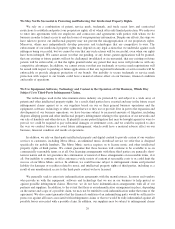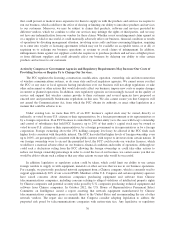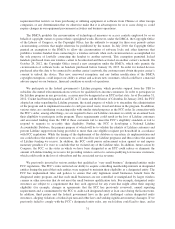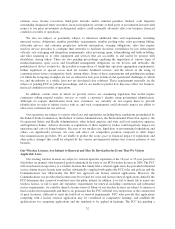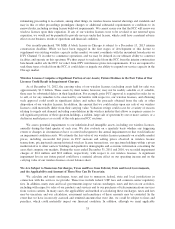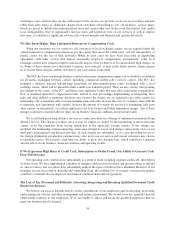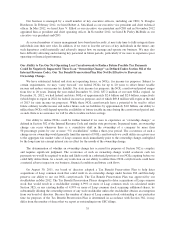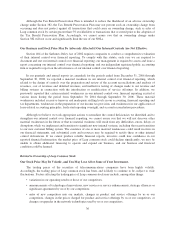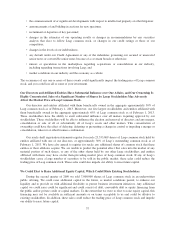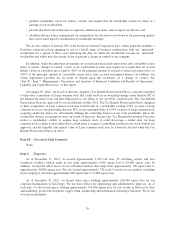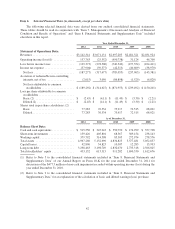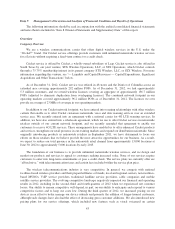Cricket Wireless 2012 Annual Report Download - page 49
Download and view the complete annual report
Please find page 49 of the 2012 Cricket Wireless annual report below. You can navigate through the pages in the report by either clicking on the pages listed below, or by using the keyword search tool below to find specific information within the annual report.Our business is managed by a small number of key executive officers, including our CEO, S. Douglas
Hutcheson. In February 2012, we hired Robert A. Strickland as our executive vice president and chief technical
officer. In May 2012, we hired Jerry V. Elliott as our executive vice president and CFO and in November 2012
appointed him as president and chief operating officer. In November 2012, we hired R. Perley McBride as our
executive vice president and CFO.
As several members of senior management have been hired recently, it may take time to fully integrate these
individuals into their new roles. In addition, if we were to lose the services of key individuals in the future, any
such departures could materially and adversely impact how we manage and operate our business. We may also
have difficulty attracting and retaining key personnel in future periods, particularly if we were to experience poor
operating or financial performance.
Our Ability to Use Our Net Operating Loss Carryforwards to Reduce Future Possible Tax Payments
Could Be Negatively Impacted if There Is an “Ownership Change” (as Defined Under Section 382 of the
Internal Revenue Code); Our Tax Benefit Preservation Plan May Not Be Effective to Prevent an
Ownership Change.
We have substantial federal and state net operating losses, or NOLs, for income tax purposes. Subject to
certain requirements, we may “carry forward” our federal NOLs for up to 20 years to offset future taxable
income and reduce our income tax liability. For state income tax purposes, the NOL carryforward period ranges
from five to 20 years. During the year ended December 31, 2012, $37.2 million of our state NOLs expired. At
December 31, 2012, we had federal and state NOLs of approximately $2.6 billion and $2.0 billion, respectively
(which begin to expire in 2022 for federal income tax purposes and of which $69.8 million will expire at the end
of 2013 for state income tax purposes). While these NOL carryforwards have a potential to be used to offset
future ordinary taxable income and reduce future cash tax liabilities by approximately $1.0 billion, our ability to
utilize these NOLs will depend upon the availability of future taxable income during the carryforward period and,
as such, there is no assurance we will be able to realize such tax savings.
Our ability to utilize NOLs could be further limited if we were to experience an “ownership change,” as
defined in Section 382 of the Internal Revenue Code and similar state provisions. In general terms, an ownership
change can occur whenever there is a cumulative shift in the ownership of a company by more than
50 percentage points by one or more “5% stockholders” within a three-year period. The occurrence of such a
change in our ownership would generally limit the amount of NOL carryforwards we could utilize in a given year
to the aggregate fair market value of Leap common stock immediately prior to the ownership change, multiplied
by the long-term tax-exempt interest rate in effect for the month of the ownership change.
The determination of whether an ownership change has occurred for purposes of Section 382 is complex
and requires significant judgment. The occurrence of such an ownership change would accelerate cash tax
payments we would be required to make and likely result in a substantial portion of our NOLs expiring before we
could fully utilize them. As a result, any restriction on our ability to utilize these NOL carryforwards could have
a material adverse impact on our business, financial condition and future cash flows.
On August 30, 2011, our board of directors adopted a Tax Benefit Preservation Plan to help deter
acquisitions of Leap common stock that could result in an ownership change under Section 382 and thus help
preserve our ability to use our NOL carryforwards. The Tax Benefit Preservation Plan was approved by our
stockholders in May 2012. The Tax Benefit Preservation Plan is designed to deter acquisitions of Leap common
stock that would result in a stockholder owning 4.99% or more of Leap common stock (as calculated under
Section 382), or any existing holder of 4.99% or more of Leap common stock acquiring additional shares, by
substantially diluting the ownership interest of any such stockholder unless the stockholder obtains an exemption
from our board of directors. Because the number of shares of Leap common stock outstanding at any particular
time for purposes of the Tax Benefit Preservation Plan is determined in accordance with Section 382, it may
differ from the number of shares that we report as outstanding in our SEC filings.
35


